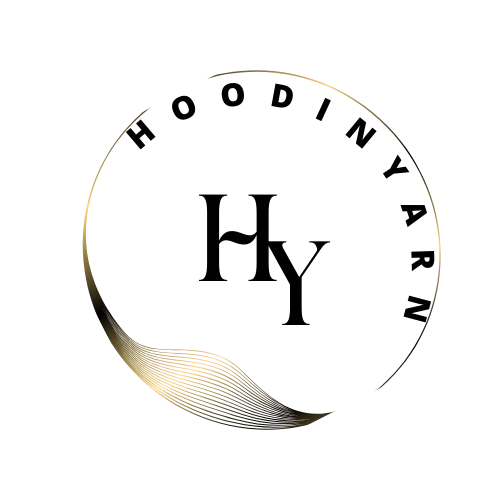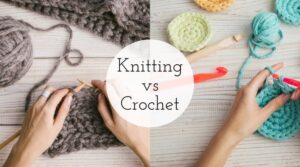
While there are some equipment and supplies that both knitting and crocheting require, each craft is distinct due to their distinctive distinctions. The following is a list of supplies you will need for both knitting and crocheting:
1. Tools and Materials for crocheting and knitting

Common Tools and Materials:
- Yarn: The most essential material for both knitting and crocheting. Yarn comes in various fibers, weights, and colors, offering endless possibilities for creativity.
- Needles/Hooks:
- Knitting Needles: Come in different types such as straight, circular, and double-pointed. They have a pointed tip to help pick up stitches.
- Crochet Hooks: Have a hook at one end to catch the yarn and pull it through loops. Crochet hooks come in different sizes and materials.
- Scissors: Used for cutting yarn and finishing off projects.
- Tape Measure: Essential for checking gauge and measuring the dimensions of your work.
- Stitch Markers: Help mark specific stitches or sections in your project.
- Yarn Needle: Used for weaving in ends and seaming pieces together.
- Pattern: Whether you’re following a written pattern or creating your own design, having a clear pattern is crucial for both knitting and crochet projects.
Knitting-Specific Tools and Materials:
- Knitting Bag: A convenient way to store and transport your knitting projects and tools.
- Stitch Holders: Used to hold stitches temporarily when working on complex patterns or shaping.
- Row Counter: Helps keep track of rows and repeats in your knitting project.
- Blocking Tools: Such as blocking mats and pins, used to shape and size your finished knitted pieces.
Crochet-Specific Tools and Materials:
- Blocking Tools: Similar to knitting, crochet projects can benefit from blocking for a polished finish.
- Crochet Stitch Markers: Designed specifically for crochet stitches, they come in different styles to suit various techniques.
- Crochet Gauge: Used to ensure your crochet stitches match the pattern’s gauge for proper sizing.
- Tunisian Crochet Hook: A specialized hook used for Tunisian crochet, which creates a fabric similar to knitting.
While knitting and crochet require some common tools and materials, each craft also has its specialized items that cater to its unique techniques and styles. Experimenting with both can lead to a well-rounded experience in the world of yarn crafts.
2. Technique for crocheting and knitting
While knitting and crocheting are two very different crafts with unique methods, they are also somewhat comparable. Below is a summary of the knitting and crocheting techniques:
Knitting Techniques:
- Casting On: This is how you start a knitting project by creating the initial row of stitches on your needle. Common methods include the long-tail cast on, knit cast on, and cable cast on.
- Knit Stitch (Garter Stitch): The basic stitch in knitting, where you insert the needle into a stitch, wrap the yarn around, and pull it through to create a new stitch.
- Purl Stitch: Another basic stitch that creates a textured pattern. It’s the reverse of the knit stitch, where you bring the yarn to the front of the work and then wrap it around the needle.
- Stockinette Stitch: Alternating rows of knit and purl stitches, creating a smooth side (knit side) and a bumpy side (purl side).
- Ribbing: A stretchy pattern created by alternating knit and purl stitches in the same row, often used for cuffs and edges.
- Increasing and Decreasing: Techniques to add or remove stitches, shaping your project.
- Cables: Creating twisted stitches that form intricate patterns, often used for texture and design in sweaters and blankets.
- Colorwork: Techniques like Fair Isle and Intarsia for adding color to your knitting projects.
Crochet Techniques:
- Slip Knot and Chain: The starting point for crochet, creating a loop on your hook.
- Single Crochet: Inserting the hook into a stitch, yarn over, pull through, yarn over again, and pull through both loops on the hook.
- Double Crochet: Similar to single crochet but with an extra yarn over before inserting the hook, creating a taller stitch.
- Half Double Crochet and Triple Crochet: Variations of double crocheting, creating different heights in your stitches.
- Crochet in the Round: Working in a continuous spiral to create projects like hats and amigurumi.
- Crochet Increases and Decreases: Similar to knitting, used for shaping and design.
- Crochet Stitch Patterns: Including shell stitch, popcorn stitch, and cluster stitch, among others, for texture and design elements.
- Color Changes: Techniques like tapestry crochet and color changes within rows for adding color to your crochet projects.
3. Creativity and Design

In order to express one’s individual style and realize creative dreams, knitters and crocheters depend heavily on creativity and design. In these crafts, creativity and design take the following forms:
Knitting:
- Stitch Patterns: Knitters have a vast array of stitch patterns to choose from, ranging from basic garter and stockinette stitches to intricate lace, cables, and colorwork patterns. Mixing and matching these patterns can create visually stunning and complex designs.
- Color Choices: Yarn comes in an endless variety of colors, gradients, and textures. Knitters can experiment with color combinations, gradients, and yarn weights to create visually striking pieces.
- Garment Design: Knitting allows for the creation of garments with custom fits and unique shaping. Designing sweaters, hats, shawls, and other wearables involves understanding shaping techniques, stitch gauge, and pattern modifications to achieve the desired look.
- Texture Play: By combining different stitch patterns, yarn types, and needle sizes, knitters can create textured fabrics that add depth and interest to their projects. Techniques like bobbles, cables, and lace add texture and dimension.
Crochet:
- Stitch Variety: Crochet offers a wide range of stitches, including basic stitches like single crochet and double crochet, as well as more intricate stitches like popcorn, shell, and cluster stitches. Crafters can use these stitches creatively to design intricate patterns and textures.
- Amigurumi and 3D Design: Crochet is well-suited for creating three-dimensional objects like stuffed animals (amigurumi), sculptures, and embellishments. Crafters can design their own patterns or modify existing ones to create unique and personalized items.
- Colorwork: Similar to knitting, crochet allows for colorwork using techniques like tapestry crochet, intarsia, and color changes within rows. Crafters can create intricate color patterns and motifs in their projects.
- Lace and Openwork: Crochet lace patterns create delicate and airy fabrics that are perfect for shawls, scarves, and decorative items. Designing lace patterns involves understanding stitch placement and yarn overs to achieve the desired lace effect.
Design Process for Both Crafts:
- Inspiration: Crafters draw inspiration from various sources such as nature, art, fashion trends, and cultural motifs. Inspiration fuels the design process and influences color choices, stitch patterns, and project themes.
- Sketching and Planning: Many crafters start with sketches or digital design tools to plan their projects. This includes sketching garment shapes, jotting down stitch patterns, and calculating yarn requirements.
- Yarn Selection: Choosing the right yarn is crucial for achieving the desired look and feel of a project. Factors such as fiber content, weight, color, and texture all contribute to the overall design.
- Pattern Modification: Experienced crafters often modify existing patterns or create their own designs. This may involve adjusting stitch counts, adding or removing elements, and customizing sizing for a personalized fit.
- Finishing Touches: Adding embellishments such as buttons, beads, embroidery, or appliqués can elevate a project’s design and add unique details.
There are countless chances for artistic expression and design development with both knitting and crocheting. Craftspeople are able to constantly improve their abilities and produce unique items that express their individual aesthetic and sense of style.
4. Community and Sharing for crocheting and knitting
In the realm of knitting and crocheting, community and sharing are essential elements that promote relationships, ingenuity, and camaraderie among artisans. These communities flourish and add to the pleasure of knitting and crocheting in the following ways:
In-Person Communities:
- Knitting/Crocheting Circles: Many cities and towns have knitting and crochet groups that meet regularly at local yarn shops, community centers, or cafes. These gatherings provide a space for crafters to share projects, exchange tips, and socialize.
- Workshops and Classes: Yarn shops and crafting organizations often host workshops and classes where crafters can learn new techniques, collaborate on projects, and connect with like-minded individuals.
- Crafting Events: Knitting and crochet events, such as yarn festivals and fiber arts conventions, bring together enthusiasts from diverse backgrounds. These events feature workshops, demonstrations, vendor booths, and social activities, creating a vibrant community atmosphere.
Online Communities:
- Social Media Groups: Platforms like Facebook, Instagram, and Reddit have dedicated groups and communities for knitters and crocheters. These online spaces allow crafters to share photos of their work, seek advice, and engage in discussions with a global community.
- Ravelry: A popular online platform for knitters, crocheters, and other fiber artists. Ravelry offers pattern sharing, forums, project pages, and groups focused on specific interests and techniques.
- Blogs and Podcasts: Many crafters share their knitting and crochet journey through blogs, podcasts, and YouTube channels. These platforms provide inspiration, tutorials, and insights into the creative process, fostering a sense of community among followers.
Benefits of Community and Sharing:
- Skill Development: Being part of a community allows crafters to learn new techniques, troubleshoot challenges, and improve their skills through shared knowledge and mentorship.
- Inspiration and Creativity: Seeing others’ projects, color choices, and design ideas can inspire crafters to try new patterns, experiment with different yarns, and push their creative boundaries.
- Support and Encouragement: Community members often offer support, encouragement, and feedback on projects. This sense of camaraderie boosts confidence and motivation, especially for beginners.
- Friendship and Networking: Many lasting friendships and professional connections are formed within knitting and crochet communities. Crafters bond over their shared passion for yarn crafts and often collaborate on projects or attend events together.
- Charity and Giving Back: Community initiatives such as charity knitting/crocheting projects, yarn bombing, and community outreach efforts allow crafters to use their skills for a greater purpose and make a positive impact in their local communities.
In general, knitting and crocheting communities offer a warm and friendly setting where artists of all abilities may interact, share their passion for fiber arts, and learn new skills.
Conclusion
Ultimately, the depth and diversity of the fiber arts community are highlighted by the similarities and differences between knitting and crochet. Creating lovely and meaningful objects is a joyful experience that transcends the differences between these two crafts, whether you’re a knitter, crocheter, or both.
According to Martha Stewart learn more about difference b/w knitting and crochet




Pingback: 4 Amazing Pros and Cons of Crocheting Vs Knitting